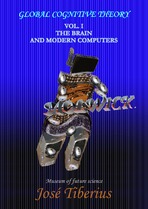2.d.2. Human brain structure and efficiency
The efficiency is easily observed as much in intelligence as in memory. The first one uses the second so as not to repeat unnecessarily a multitude of operations; it even creates subprograms of automatic action, like the pre-defined responses to different situations when driving.
It could be half of the memory deals with data to support intelligence, independently of the stored information with a system of multiple references.
The memory, or better said, the memory manager, will try to save only the relevant information, which does not already exist or adding a new nuance to stored data.
2.d.3. Utilization of idle resources
The thought is not unique; that is, there is more than one line of argument simultaneously. Moreover, the human brain allows at least two more. It would be like the existence of a somewhat conscious thought that is, however, in the background.
It should not be confused with thinking about two things at the same time; in this case, the two things are in the foreground of thought.
On the one hand, it is taking advantage of the system's idle resources, and on the other, the mind would always continue to think.
A blank mind occurs when two simultaneous ideas end at the same time; it usually happens when trying to go back in a line of argument, which is not always easy or feasible.
The fact that computers already do something similar and are becoming increasingly complex needs no further explanation.
2.d.4. Maintenance of cognitive capacity
Given the intricacy of the brain structure and the necessity to maintain an optimum operational ability, the system needs to reorganize itself daily. While sleeping, it performs a significant amount of cleaning work.

A critical reason for sleeping is the brain needs to use the working memory and the relational capacity intensively for the exploitation analysis of daily experience stored in the short-term memory faced with its possible store o deletion, so these abilities need to be free from a multitude of conscious tasks.
Dreams widely represent the work that the memory manager performs when storing specific information. When it does not know what to do, because it lacks enough information, it recreates a situation and tries to force the intelligence to choose. The brain will clean short-term memory without losing data or saving a full specific subject provisionally.
When intelligence does not manage to offer a clear decision for a topic, there could appear recurrent dreams. The issue is noteworthy, and the adopted solution would affect the saving of data in different places in the memory or the configuration a dimensional reference.
The difficulty degree of some relational problems may be so high that, at certain times, the quickest solution to a problem is to forget it and try it later, especially after sleeping. Any experienced programmer knows that faced with an elemental problem that seems irresolvable, one should try to shut down the computer and try it again.
In the first case, after sleeping, short-term memory has been cleaned. When it analyses the problem again, it will load every data related and in agreement with the priorities of each element; then, the analysis is notably more straightforward.
After restarting a computer, all the programs and variables in the memory have disappeared, and the computer will load into RAM only the necessary programs and variables. The restart assures there is free space and that none of the variables have erroneous values from multiple tests performed by a programmer.
Another yet different example of how the brain structure works is the human eye. The eye adapts best to sudden changes in luminosity by opening and closing the lids, that is, by restarting the system. The latter is vital for those who drive for long periods at night. The light from cars provokes sudden changes in the luminosity that can be tiresome for the eyes.
However, it is fascinating to check that, if the eyes blink right when faced with a sudden change in light, the fatigue and the discomfort reduces stunningly. There must be mechanisms to adjust to luminosity and optimized to initialize from the darkness.
